GRAD 695 Assignment: Literature Review on Agile in Healthcare Quality
VerifiedAdded on 2023/01/11
|10
|2182
|93
Homework Assignment
AI Summary
This document presents a literature review focused on the application of agile principles within the healthcare industry to improve the quality of care. The review analyzes four key sources, each examining different aspects of agile implementation. Sindhwani et al. (2019) explore the use of agile systems to enhance patient care, optimize costs, and streamline workflows. Maijala et al. (2018) focus on leadership and management aspects of lean methodologies, which complement agile approaches. Budrionis and Bellika (2016) investigate learning healthcare systems and how agile principles can be applied to improve collaboration and patient outcomes. Finally, Tolf et al. (2015) discuss the potential of agile principles for hospital managers, emphasizing the need for customer focus and market sensitivity. The review highlights the benefits of agile, such as improved efficiency, reduced costs, and better patient care, while also identifying gaps in the literature and suggesting areas for future research, including the need for experimental studies and outcome measurements to fully validate the impact of agile principles. The author connects the literature to their GRAD 695 research, emphasizing how agile principles can be applied to improve healthcare quality, address the global burden of disease, and ensure equitable access to care.
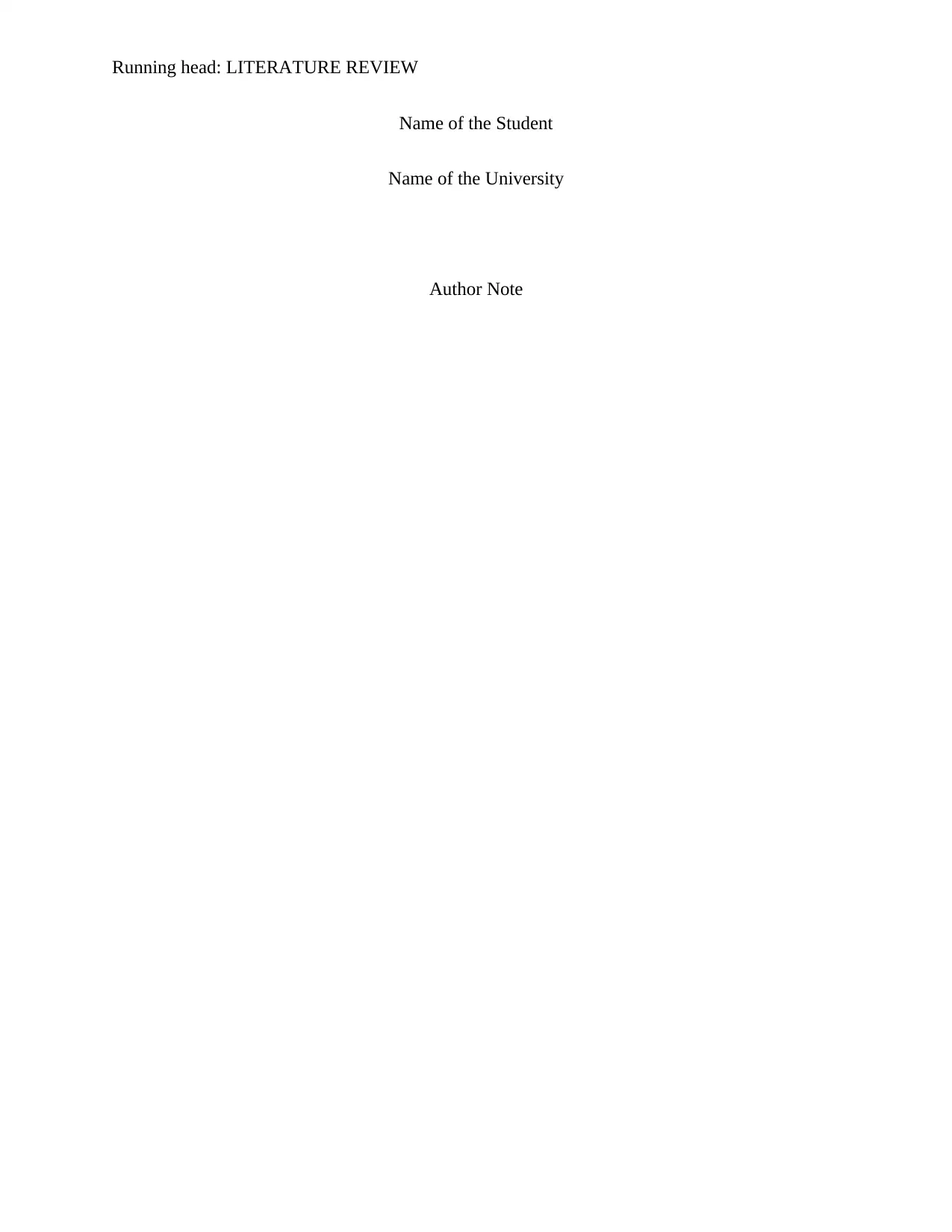
Running head: LITERATURE REVIEW
Name of the Student
Name of the University
Author Note
Name of the Student
Name of the University
Author Note
Paraphrase This Document
Need a fresh take? Get an instant paraphrase of this document with our AI Paraphraser
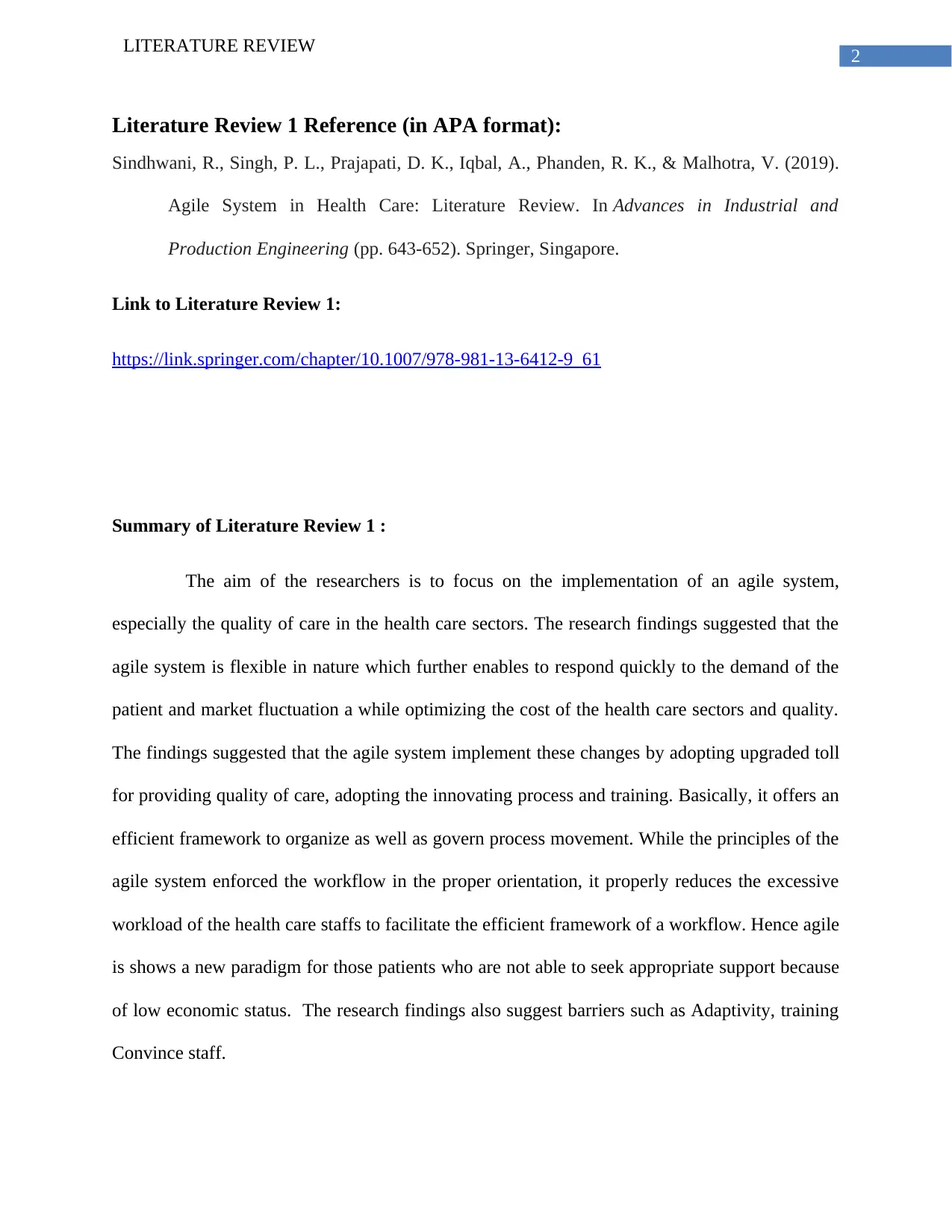
2
LITERATURE REVIEW
Literature Review 1 Reference (in APA format):
Sindhwani, R., Singh, P. L., Prajapati, D. K., Iqbal, A., Phanden, R. K., & Malhotra, V. (2019).
Agile System in Health Care: Literature Review. In Advances in Industrial and
Production Engineering (pp. 643-652). Springer, Singapore.
Link to Literature Review 1:
https://link.springer.com/chapter/10.1007/978-981-13-6412-9_61
Summary of Literature Review 1 :
The aim of the researchers is to focus on the implementation of an agile system,
especially the quality of care in the health care sectors. The research findings suggested that the
agile system is flexible in nature which further enables to respond quickly to the demand of the
patient and market fluctuation a while optimizing the cost of the health care sectors and quality.
The findings suggested that the agile system implement these changes by adopting upgraded toll
for providing quality of care, adopting the innovating process and training. Basically, it offers an
efficient framework to organize as well as govern process movement. While the principles of the
agile system enforced the workflow in the proper orientation, it properly reduces the excessive
workload of the health care staffs to facilitate the efficient framework of a workflow. Hence agile
is shows a new paradigm for those patients who are not able to seek appropriate support because
of low economic status. The research findings also suggest barriers such as Adaptivity, training
Convince staff.
LITERATURE REVIEW
Literature Review 1 Reference (in APA format):
Sindhwani, R., Singh, P. L., Prajapati, D. K., Iqbal, A., Phanden, R. K., & Malhotra, V. (2019).
Agile System in Health Care: Literature Review. In Advances in Industrial and
Production Engineering (pp. 643-652). Springer, Singapore.
Link to Literature Review 1:
https://link.springer.com/chapter/10.1007/978-981-13-6412-9_61
Summary of Literature Review 1 :
The aim of the researchers is to focus on the implementation of an agile system,
especially the quality of care in the health care sectors. The research findings suggested that the
agile system is flexible in nature which further enables to respond quickly to the demand of the
patient and market fluctuation a while optimizing the cost of the health care sectors and quality.
The findings suggested that the agile system implement these changes by adopting upgraded toll
for providing quality of care, adopting the innovating process and training. Basically, it offers an
efficient framework to organize as well as govern process movement. While the principles of the
agile system enforced the workflow in the proper orientation, it properly reduces the excessive
workload of the health care staffs to facilitate the efficient framework of a workflow. Hence agile
is shows a new paradigm for those patients who are not able to seek appropriate support because
of low economic status. The research findings also suggest barriers such as Adaptivity, training
Convince staff.
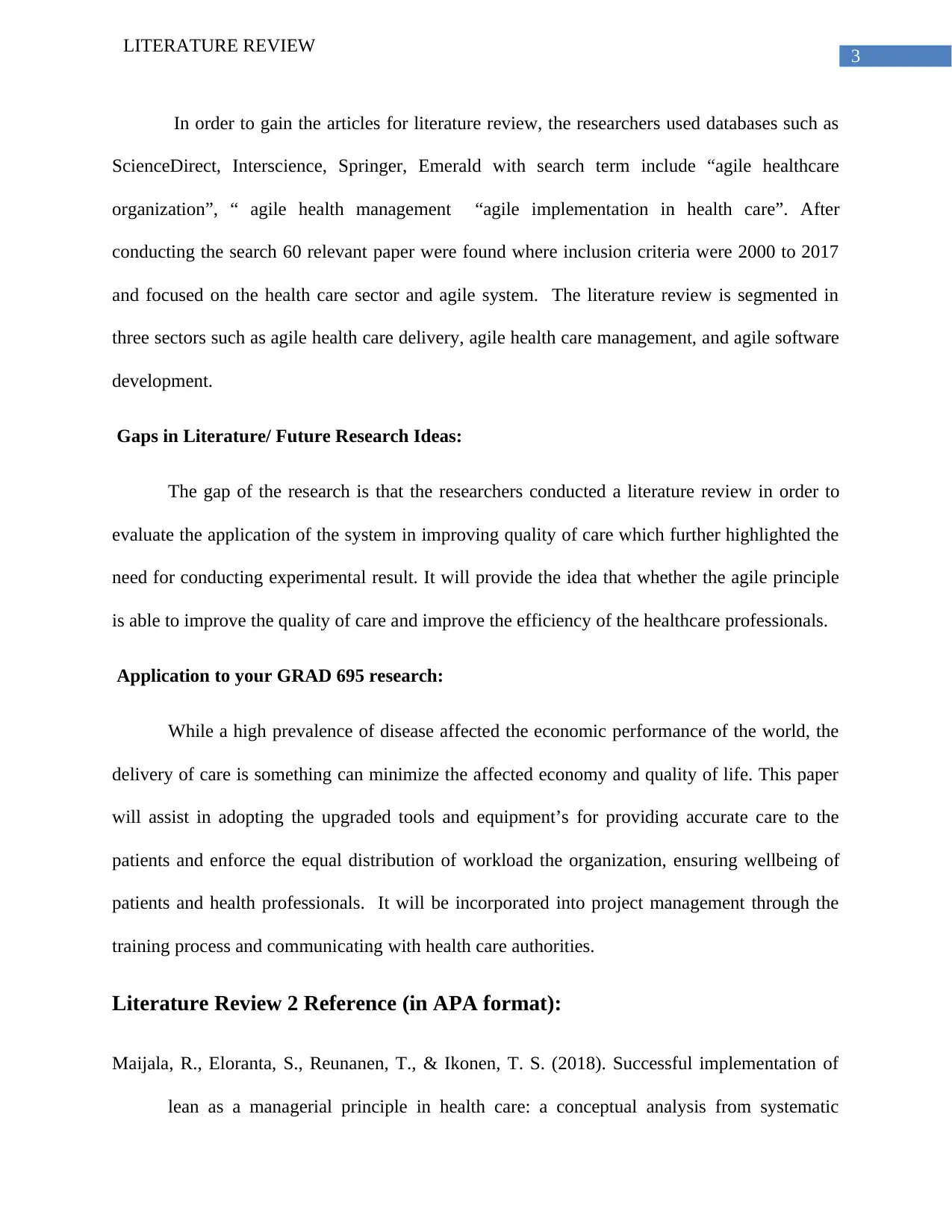
3
LITERATURE REVIEW
In order to gain the articles for literature review, the researchers used databases such as
ScienceDirect, Interscience, Springer, Emerald with search term include “agile healthcare
organization”, “ agile health management “agile implementation in health care”. After
conducting the search 60 relevant paper were found where inclusion criteria were 2000 to 2017
and focused on the health care sector and agile system. The literature review is segmented in
three sectors such as agile health care delivery, agile health care management, and agile software
development.
Gaps in Literature/ Future Research Ideas:
The gap of the research is that the researchers conducted a literature review in order to
evaluate the application of the system in improving quality of care which further highlighted the
need for conducting experimental result. It will provide the idea that whether the agile principle
is able to improve the quality of care and improve the efficiency of the healthcare professionals.
Application to your GRAD 695 research:
While a high prevalence of disease affected the economic performance of the world, the
delivery of care is something can minimize the affected economy and quality of life. This paper
will assist in adopting the upgraded tools and equipment’s for providing accurate care to the
patients and enforce the equal distribution of workload the organization, ensuring wellbeing of
patients and health professionals. It will be incorporated into project management through the
training process and communicating with health care authorities.
Literature Review 2 Reference (in APA format):
Maijala, R., Eloranta, S., Reunanen, T., & Ikonen, T. S. (2018). Successful implementation of
lean as a managerial principle in health care: a conceptual analysis from systematic
LITERATURE REVIEW
In order to gain the articles for literature review, the researchers used databases such as
ScienceDirect, Interscience, Springer, Emerald with search term include “agile healthcare
organization”, “ agile health management “agile implementation in health care”. After
conducting the search 60 relevant paper were found where inclusion criteria were 2000 to 2017
and focused on the health care sector and agile system. The literature review is segmented in
three sectors such as agile health care delivery, agile health care management, and agile software
development.
Gaps in Literature/ Future Research Ideas:
The gap of the research is that the researchers conducted a literature review in order to
evaluate the application of the system in improving quality of care which further highlighted the
need for conducting experimental result. It will provide the idea that whether the agile principle
is able to improve the quality of care and improve the efficiency of the healthcare professionals.
Application to your GRAD 695 research:
While a high prevalence of disease affected the economic performance of the world, the
delivery of care is something can minimize the affected economy and quality of life. This paper
will assist in adopting the upgraded tools and equipment’s for providing accurate care to the
patients and enforce the equal distribution of workload the organization, ensuring wellbeing of
patients and health professionals. It will be incorporated into project management through the
training process and communicating with health care authorities.
Literature Review 2 Reference (in APA format):
Maijala, R., Eloranta, S., Reunanen, T., & Ikonen, T. S. (2018). Successful implementation of
lean as a managerial principle in health care: a conceptual analysis from systematic
⊘ This is a preview!⊘
Do you want full access?
Subscribe today to unlock all pages.

Trusted by 1+ million students worldwide
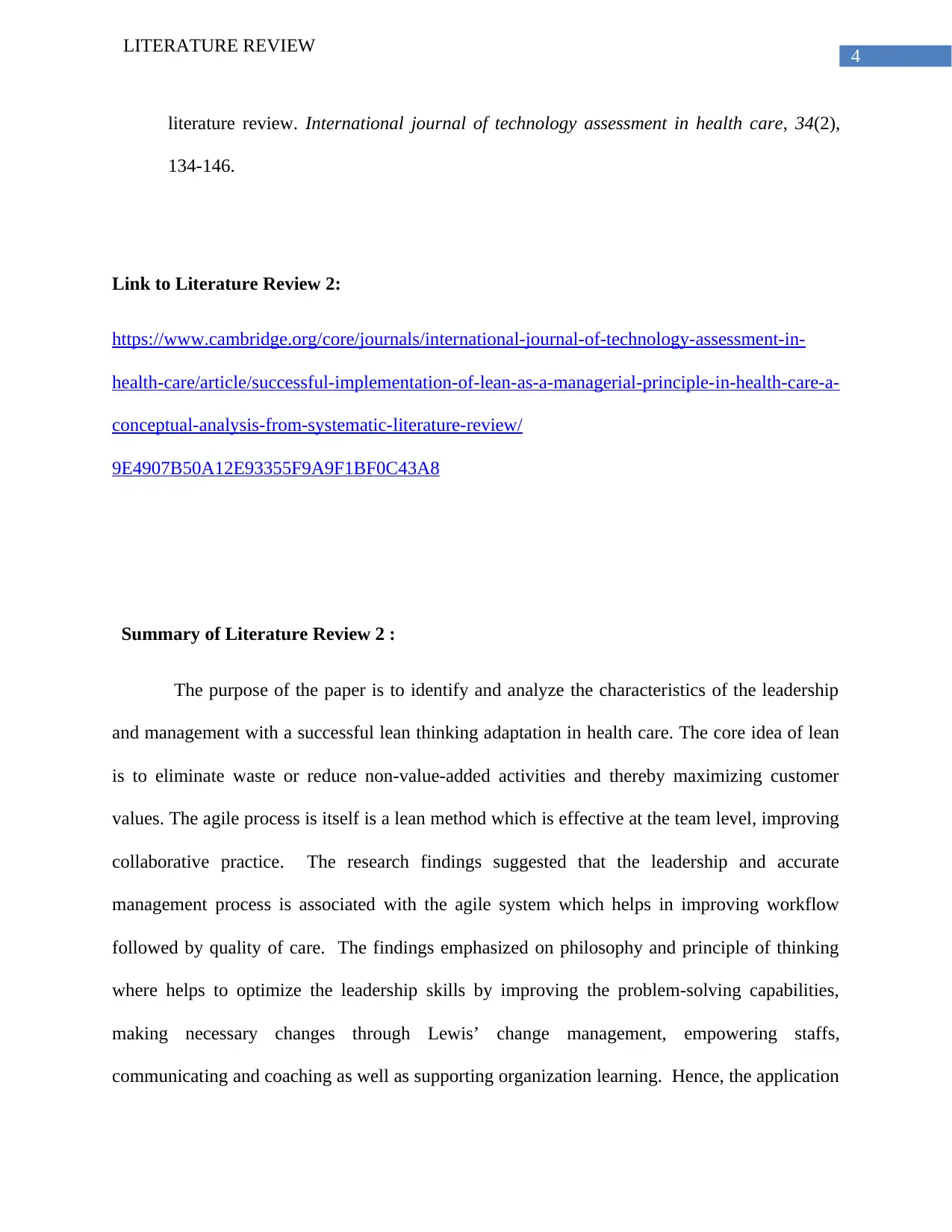
4
LITERATURE REVIEW
literature review. International journal of technology assessment in health care, 34(2),
134-146.
Link to Literature Review 2:
https://www.cambridge.org/core/journals/international-journal-of-technology-assessment-in-
health-care/article/successful-implementation-of-lean-as-a-managerial-principle-in-health-care-a-
conceptual-analysis-from-systematic-literature-review/
9E4907B50A12E93355F9A9F1BF0C43A8
Summary of Literature Review 2 :
The purpose of the paper is to identify and analyze the characteristics of the leadership
and management with a successful lean thinking adaptation in health care. The core idea of lean
is to eliminate waste or reduce non-value-added activities and thereby maximizing customer
values. The agile process is itself is a lean method which is effective at the team level, improving
collaborative practice. The research findings suggested that the leadership and accurate
management process is associated with the agile system which helps in improving workflow
followed by quality of care. The findings emphasized on philosophy and principle of thinking
where helps to optimize the leadership skills by improving the problem-solving capabilities,
making necessary changes through Lewis’ change management, empowering staffs,
communicating and coaching as well as supporting organization learning. Hence, the application
LITERATURE REVIEW
literature review. International journal of technology assessment in health care, 34(2),
134-146.
Link to Literature Review 2:
https://www.cambridge.org/core/journals/international-journal-of-technology-assessment-in-
health-care/article/successful-implementation-of-lean-as-a-managerial-principle-in-health-care-a-
conceptual-analysis-from-systematic-literature-review/
9E4907B50A12E93355F9A9F1BF0C43A8
Summary of Literature Review 2 :
The purpose of the paper is to identify and analyze the characteristics of the leadership
and management with a successful lean thinking adaptation in health care. The core idea of lean
is to eliminate waste or reduce non-value-added activities and thereby maximizing customer
values. The agile process is itself is a lean method which is effective at the team level, improving
collaborative practice. The research findings suggested that the leadership and accurate
management process is associated with the agile system which helps in improving workflow
followed by quality of care. The findings emphasized on philosophy and principle of thinking
where helps to optimize the leadership skills by improving the problem-solving capabilities,
making necessary changes through Lewis’ change management, empowering staffs,
communicating and coaching as well as supporting organization learning. Hence, the application
Paraphrase This Document
Need a fresh take? Get an instant paraphrase of this document with our AI Paraphraser
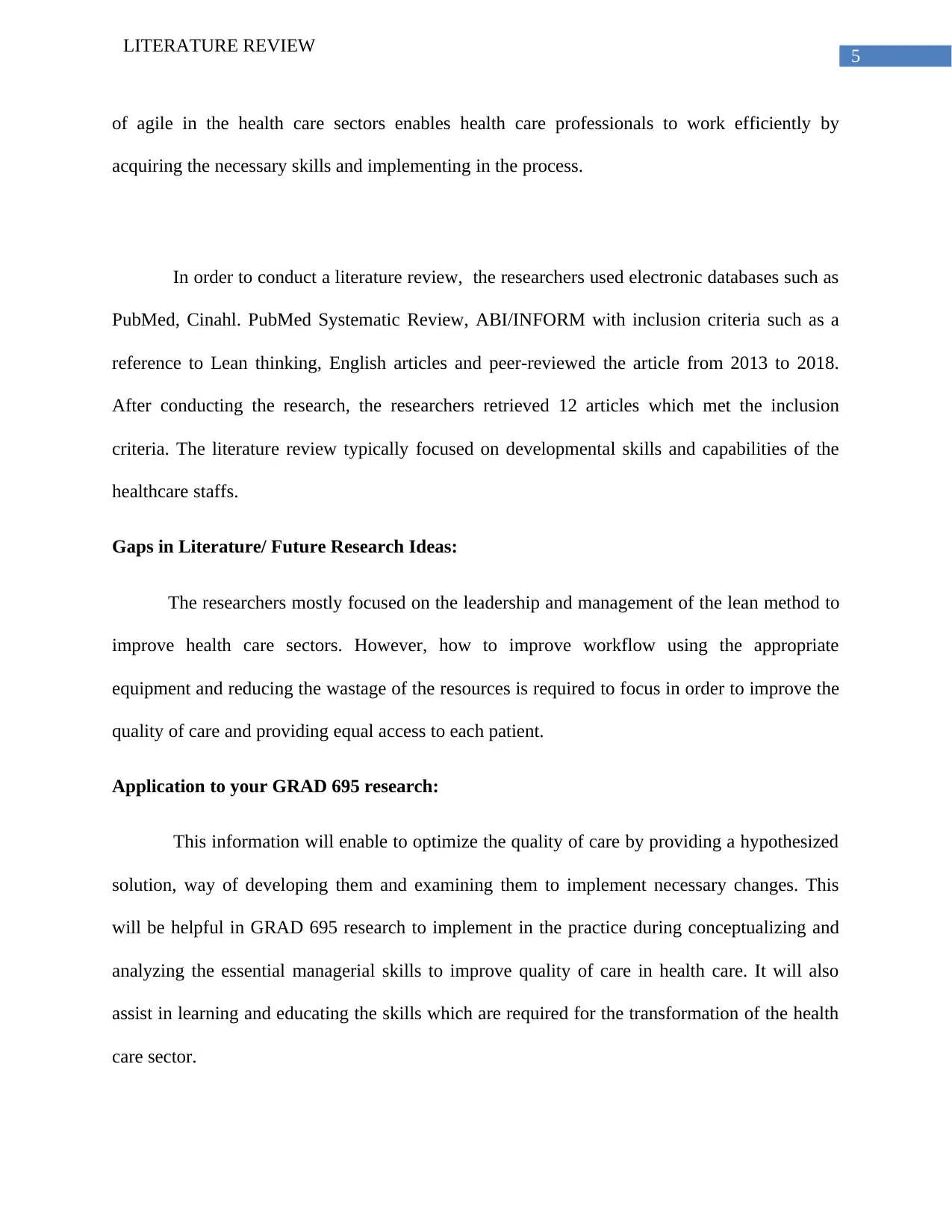
5
LITERATURE REVIEW
of agile in the health care sectors enables health care professionals to work efficiently by
acquiring the necessary skills and implementing in the process.
In order to conduct a literature review, the researchers used electronic databases such as
PubMed, Cinahl. PubMed Systematic Review, ABI/INFORM with inclusion criteria such as a
reference to Lean thinking, English articles and peer-reviewed the article from 2013 to 2018.
After conducting the research, the researchers retrieved 12 articles which met the inclusion
criteria. The literature review typically focused on developmental skills and capabilities of the
healthcare staffs.
Gaps in Literature/ Future Research Ideas:
The researchers mostly focused on the leadership and management of the lean method to
improve health care sectors. However, how to improve workflow using the appropriate
equipment and reducing the wastage of the resources is required to focus in order to improve the
quality of care and providing equal access to each patient.
Application to your GRAD 695 research:
This information will enable to optimize the quality of care by providing a hypothesized
solution, way of developing them and examining them to implement necessary changes. This
will be helpful in GRAD 695 research to implement in the practice during conceptualizing and
analyzing the essential managerial skills to improve quality of care in health care. It will also
assist in learning and educating the skills which are required for the transformation of the health
care sector.
LITERATURE REVIEW
of agile in the health care sectors enables health care professionals to work efficiently by
acquiring the necessary skills and implementing in the process.
In order to conduct a literature review, the researchers used electronic databases such as
PubMed, Cinahl. PubMed Systematic Review, ABI/INFORM with inclusion criteria such as a
reference to Lean thinking, English articles and peer-reviewed the article from 2013 to 2018.
After conducting the research, the researchers retrieved 12 articles which met the inclusion
criteria. The literature review typically focused on developmental skills and capabilities of the
healthcare staffs.
Gaps in Literature/ Future Research Ideas:
The researchers mostly focused on the leadership and management of the lean method to
improve health care sectors. However, how to improve workflow using the appropriate
equipment and reducing the wastage of the resources is required to focus in order to improve the
quality of care and providing equal access to each patient.
Application to your GRAD 695 research:
This information will enable to optimize the quality of care by providing a hypothesized
solution, way of developing them and examining them to implement necessary changes. This
will be helpful in GRAD 695 research to implement in the practice during conceptualizing and
analyzing the essential managerial skills to improve quality of care in health care. It will also
assist in learning and educating the skills which are required for the transformation of the health
care sector.
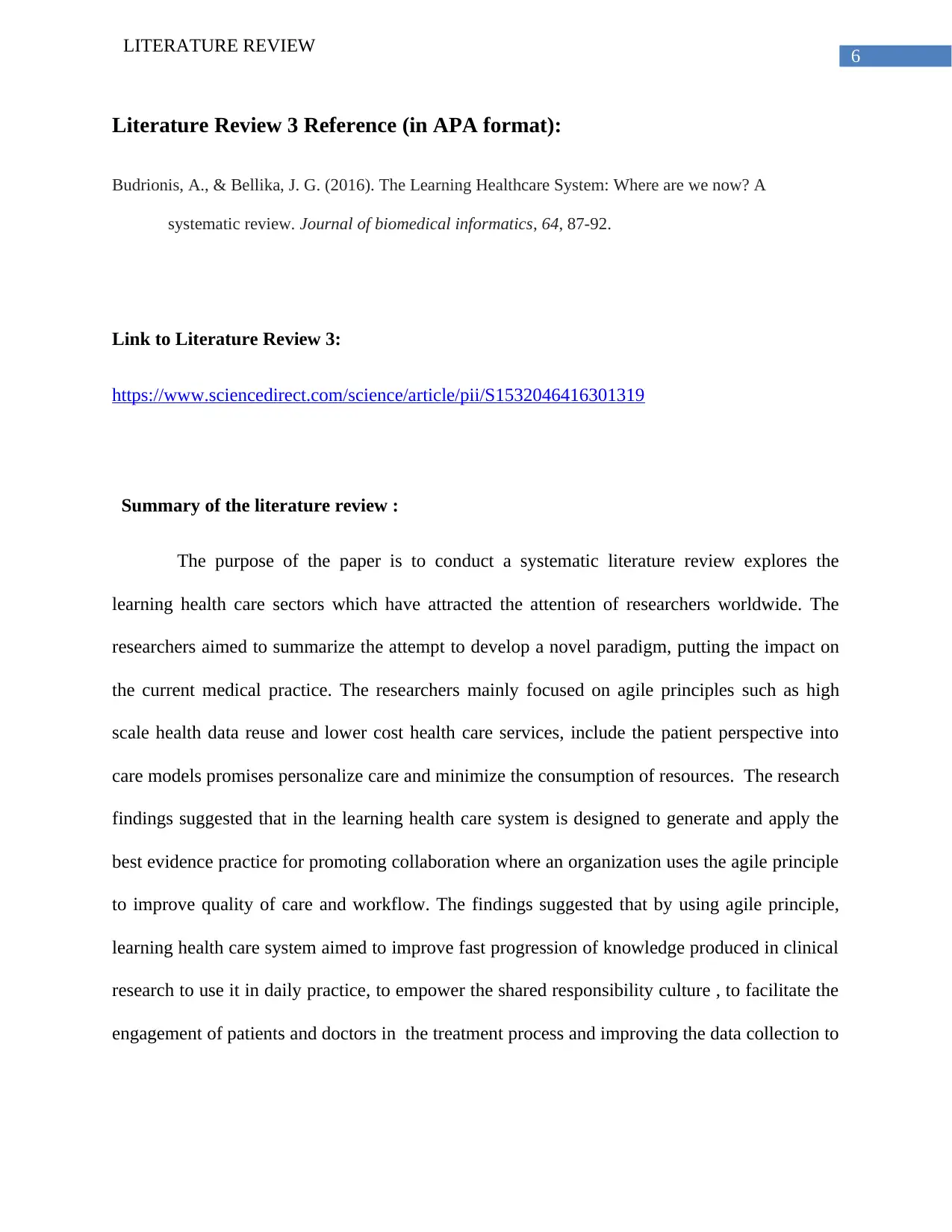
6
LITERATURE REVIEW
Literature Review 3 Reference (in APA format):
Budrionis, A., & Bellika, J. G. (2016). The Learning Healthcare System: Where are we now? A
systematic review. Journal of biomedical informatics, 64, 87-92.
Link to Literature Review 3:
https://www.sciencedirect.com/science/article/pii/S1532046416301319
Summary of the literature review :
The purpose of the paper is to conduct a systematic literature review explores the
learning health care sectors which have attracted the attention of researchers worldwide. The
researchers aimed to summarize the attempt to develop a novel paradigm, putting the impact on
the current medical practice. The researchers mainly focused on agile principles such as high
scale health data reuse and lower cost health care services, include the patient perspective into
care models promises personalize care and minimize the consumption of resources. The research
findings suggested that in the learning health care system is designed to generate and apply the
best evidence practice for promoting collaboration where an organization uses the agile principle
to improve quality of care and workflow. The findings suggested that by using agile principle,
learning health care system aimed to improve fast progression of knowledge produced in clinical
research to use it in daily practice, to empower the shared responsibility culture , to facilitate the
engagement of patients and doctors in the treatment process and improving the data collection to
LITERATURE REVIEW
Literature Review 3 Reference (in APA format):
Budrionis, A., & Bellika, J. G. (2016). The Learning Healthcare System: Where are we now? A
systematic review. Journal of biomedical informatics, 64, 87-92.
Link to Literature Review 3:
https://www.sciencedirect.com/science/article/pii/S1532046416301319
Summary of the literature review :
The purpose of the paper is to conduct a systematic literature review explores the
learning health care sectors which have attracted the attention of researchers worldwide. The
researchers aimed to summarize the attempt to develop a novel paradigm, putting the impact on
the current medical practice. The researchers mainly focused on agile principles such as high
scale health data reuse and lower cost health care services, include the patient perspective into
care models promises personalize care and minimize the consumption of resources. The research
findings suggested that in the learning health care system is designed to generate and apply the
best evidence practice for promoting collaboration where an organization uses the agile principle
to improve quality of care and workflow. The findings suggested that by using agile principle,
learning health care system aimed to improve fast progression of knowledge produced in clinical
research to use it in daily practice, to empower the shared responsibility culture , to facilitate the
engagement of patients and doctors in the treatment process and improving the data collection to
⊘ This is a preview!⊘
Do you want full access?
Subscribe today to unlock all pages.

Trusted by 1+ million students worldwide
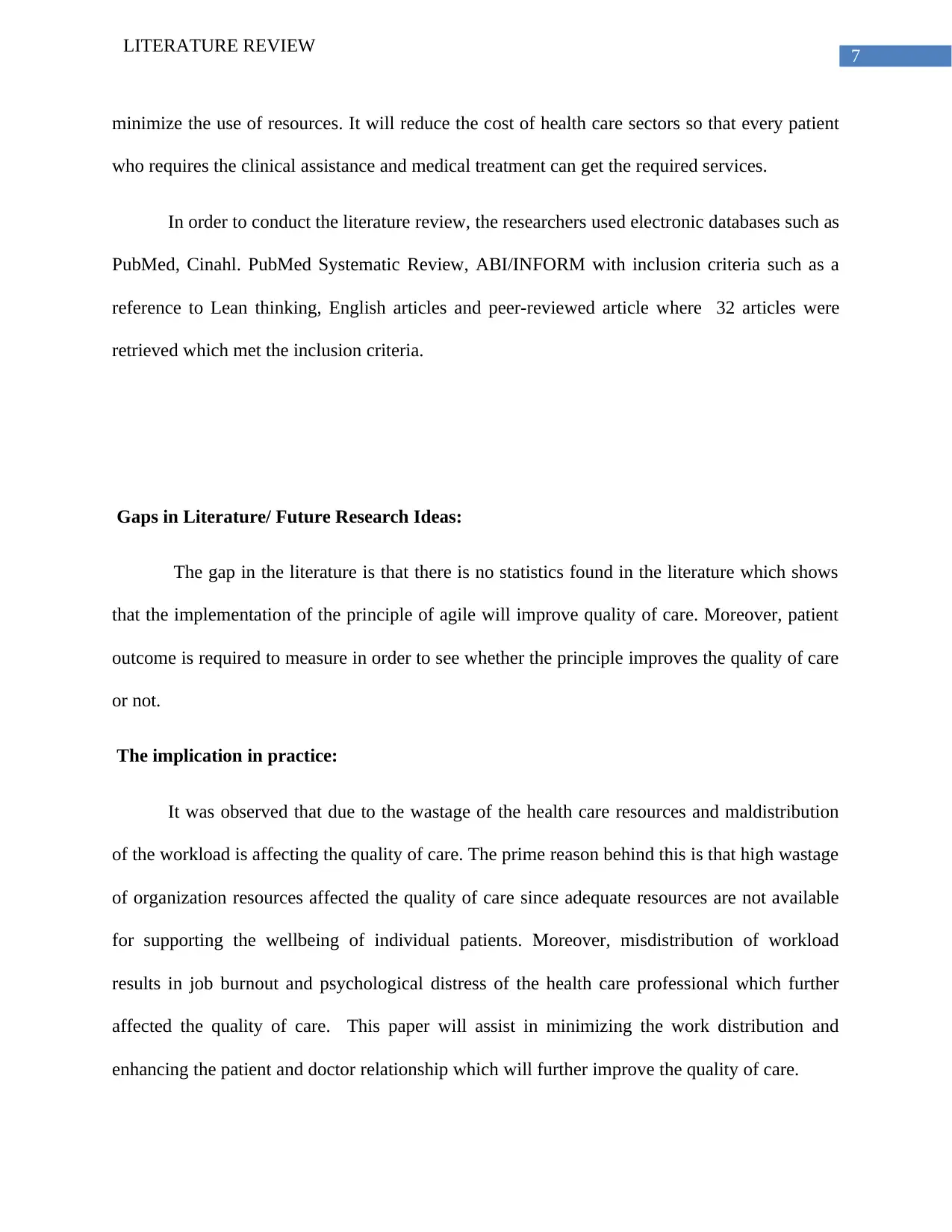
7
LITERATURE REVIEW
minimize the use of resources. It will reduce the cost of health care sectors so that every patient
who requires the clinical assistance and medical treatment can get the required services.
In order to conduct the literature review, the researchers used electronic databases such as
PubMed, Cinahl. PubMed Systematic Review, ABI/INFORM with inclusion criteria such as a
reference to Lean thinking, English articles and peer-reviewed article where 32 articles were
retrieved which met the inclusion criteria.
Gaps in Literature/ Future Research Ideas:
The gap in the literature is that there is no statistics found in the literature which shows
that the implementation of the principle of agile will improve quality of care. Moreover, patient
outcome is required to measure in order to see whether the principle improves the quality of care
or not.
The implication in practice:
It was observed that due to the wastage of the health care resources and maldistribution
of the workload is affecting the quality of care. The prime reason behind this is that high wastage
of organization resources affected the quality of care since adequate resources are not available
for supporting the wellbeing of individual patients. Moreover, misdistribution of workload
results in job burnout and psychological distress of the health care professional which further
affected the quality of care. This paper will assist in minimizing the work distribution and
enhancing the patient and doctor relationship which will further improve the quality of care.
LITERATURE REVIEW
minimize the use of resources. It will reduce the cost of health care sectors so that every patient
who requires the clinical assistance and medical treatment can get the required services.
In order to conduct the literature review, the researchers used electronic databases such as
PubMed, Cinahl. PubMed Systematic Review, ABI/INFORM with inclusion criteria such as a
reference to Lean thinking, English articles and peer-reviewed article where 32 articles were
retrieved which met the inclusion criteria.
Gaps in Literature/ Future Research Ideas:
The gap in the literature is that there is no statistics found in the literature which shows
that the implementation of the principle of agile will improve quality of care. Moreover, patient
outcome is required to measure in order to see whether the principle improves the quality of care
or not.
The implication in practice:
It was observed that due to the wastage of the health care resources and maldistribution
of the workload is affecting the quality of care. The prime reason behind this is that high wastage
of organization resources affected the quality of care since adequate resources are not available
for supporting the wellbeing of individual patients. Moreover, misdistribution of workload
results in job burnout and psychological distress of the health care professional which further
affected the quality of care. This paper will assist in minimizing the work distribution and
enhancing the patient and doctor relationship which will further improve the quality of care.
Paraphrase This Document
Need a fresh take? Get an instant paraphrase of this document with our AI Paraphraser
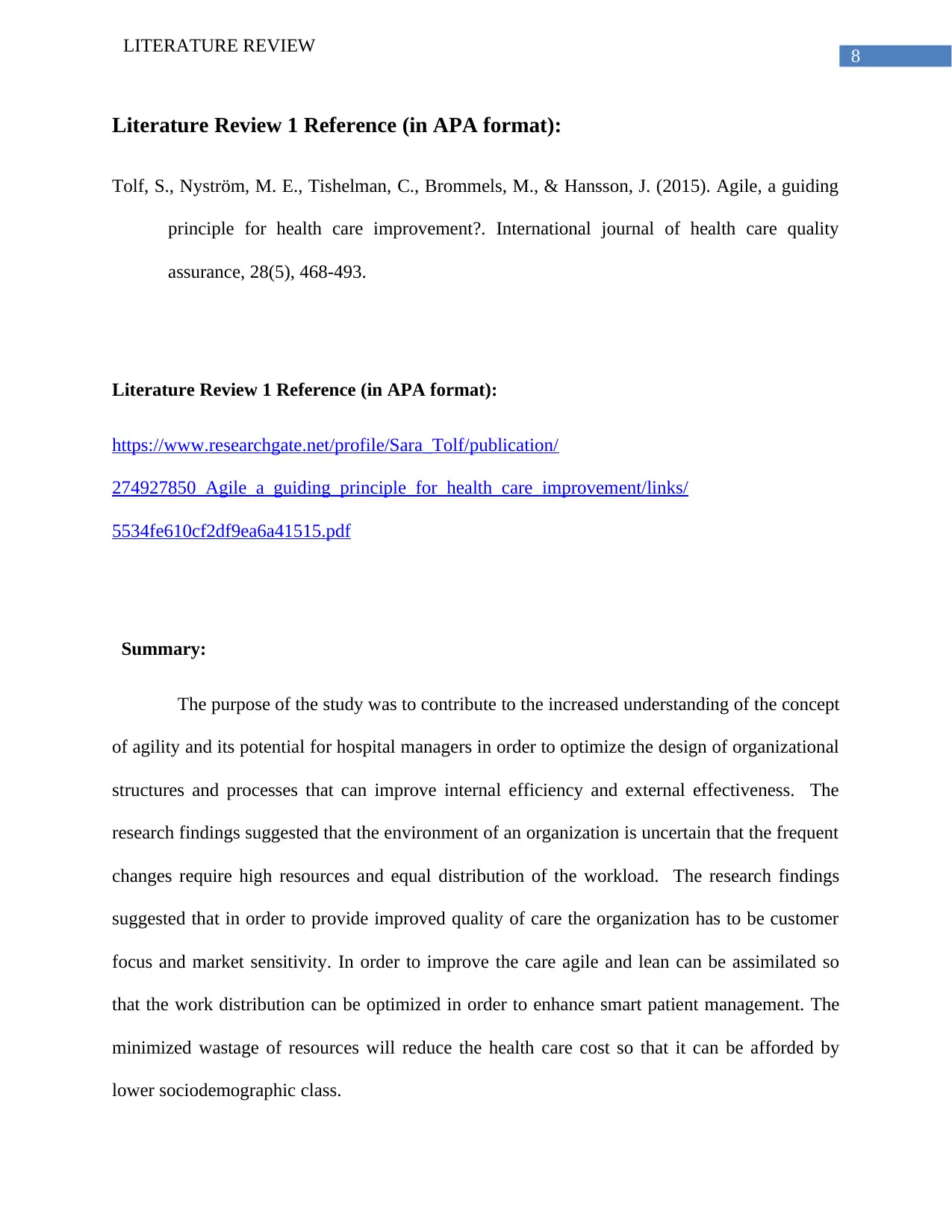
8
LITERATURE REVIEW
Literature Review 1 Reference (in APA format):
Tolf, S., Nyström, M. E., Tishelman, C., Brommels, M., & Hansson, J. (2015). Agile, a guiding
principle for health care improvement?. International journal of health care quality
assurance, 28(5), 468-493.
Literature Review 1 Reference (in APA format):
https://www.researchgate.net/profile/Sara_Tolf/publication/
274927850_Agile_a_guiding_principle_for_health_care_improvement/links/
5534fe610cf2df9ea6a41515.pdf
Summary:
The purpose of the study was to contribute to the increased understanding of the concept
of agility and its potential for hospital managers in order to optimize the design of organizational
structures and processes that can improve internal efficiency and external effectiveness. The
research findings suggested that the environment of an organization is uncertain that the frequent
changes require high resources and equal distribution of the workload. The research findings
suggested that in order to provide improved quality of care the organization has to be customer
focus and market sensitivity. In order to improve the care agile and lean can be assimilated so
that the work distribution can be optimized in order to enhance smart patient management. The
minimized wastage of resources will reduce the health care cost so that it can be afforded by
lower sociodemographic class.
LITERATURE REVIEW
Literature Review 1 Reference (in APA format):
Tolf, S., Nyström, M. E., Tishelman, C., Brommels, M., & Hansson, J. (2015). Agile, a guiding
principle for health care improvement?. International journal of health care quality
assurance, 28(5), 468-493.
Literature Review 1 Reference (in APA format):
https://www.researchgate.net/profile/Sara_Tolf/publication/
274927850_Agile_a_guiding_principle_for_health_care_improvement/links/
5534fe610cf2df9ea6a41515.pdf
Summary:
The purpose of the study was to contribute to the increased understanding of the concept
of agility and its potential for hospital managers in order to optimize the design of organizational
structures and processes that can improve internal efficiency and external effectiveness. The
research findings suggested that the environment of an organization is uncertain that the frequent
changes require high resources and equal distribution of the workload. The research findings
suggested that in order to provide improved quality of care the organization has to be customer
focus and market sensitivity. In order to improve the care agile and lean can be assimilated so
that the work distribution can be optimized in order to enhance smart patient management. The
minimized wastage of resources will reduce the health care cost so that it can be afforded by
lower sociodemographic class.
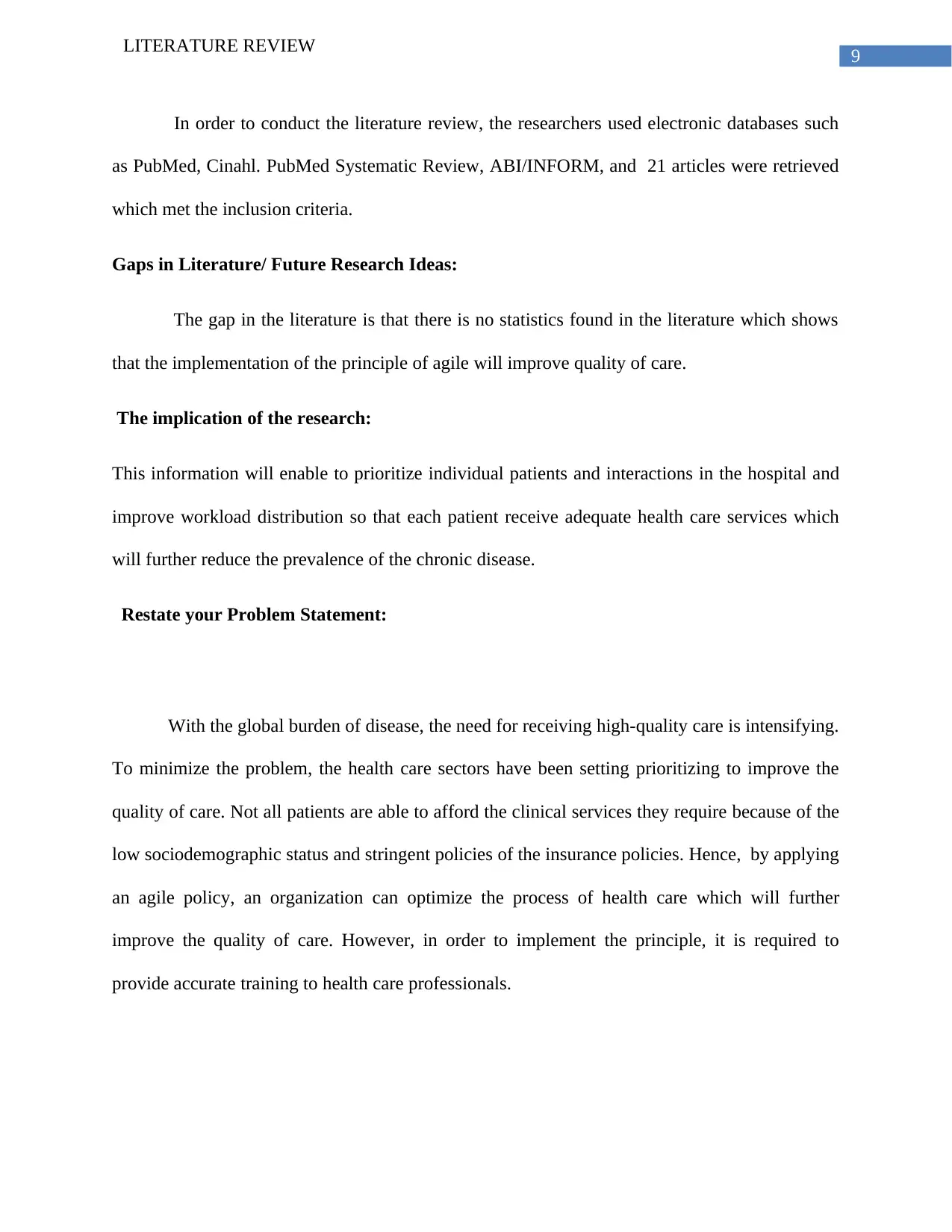
9
LITERATURE REVIEW
In order to conduct the literature review, the researchers used electronic databases such
as PubMed, Cinahl. PubMed Systematic Review, ABI/INFORM, and 21 articles were retrieved
which met the inclusion criteria.
Gaps in Literature/ Future Research Ideas:
The gap in the literature is that there is no statistics found in the literature which shows
that the implementation of the principle of agile will improve quality of care.
The implication of the research:
This information will enable to prioritize individual patients and interactions in the hospital and
improve workload distribution so that each patient receive adequate health care services which
will further reduce the prevalence of the chronic disease.
Restate your Problem Statement:
With the global burden of disease, the need for receiving high-quality care is intensifying.
To minimize the problem, the health care sectors have been setting prioritizing to improve the
quality of care. Not all patients are able to afford the clinical services they require because of the
low sociodemographic status and stringent policies of the insurance policies. Hence, by applying
an agile policy, an organization can optimize the process of health care which will further
improve the quality of care. However, in order to implement the principle, it is required to
provide accurate training to health care professionals.
LITERATURE REVIEW
In order to conduct the literature review, the researchers used electronic databases such
as PubMed, Cinahl. PubMed Systematic Review, ABI/INFORM, and 21 articles were retrieved
which met the inclusion criteria.
Gaps in Literature/ Future Research Ideas:
The gap in the literature is that there is no statistics found in the literature which shows
that the implementation of the principle of agile will improve quality of care.
The implication of the research:
This information will enable to prioritize individual patients and interactions in the hospital and
improve workload distribution so that each patient receive adequate health care services which
will further reduce the prevalence of the chronic disease.
Restate your Problem Statement:
With the global burden of disease, the need for receiving high-quality care is intensifying.
To minimize the problem, the health care sectors have been setting prioritizing to improve the
quality of care. Not all patients are able to afford the clinical services they require because of the
low sociodemographic status and stringent policies of the insurance policies. Hence, by applying
an agile policy, an organization can optimize the process of health care which will further
improve the quality of care. However, in order to implement the principle, it is required to
provide accurate training to health care professionals.
⊘ This is a preview!⊘
Do you want full access?
Subscribe today to unlock all pages.

Trusted by 1+ million students worldwide
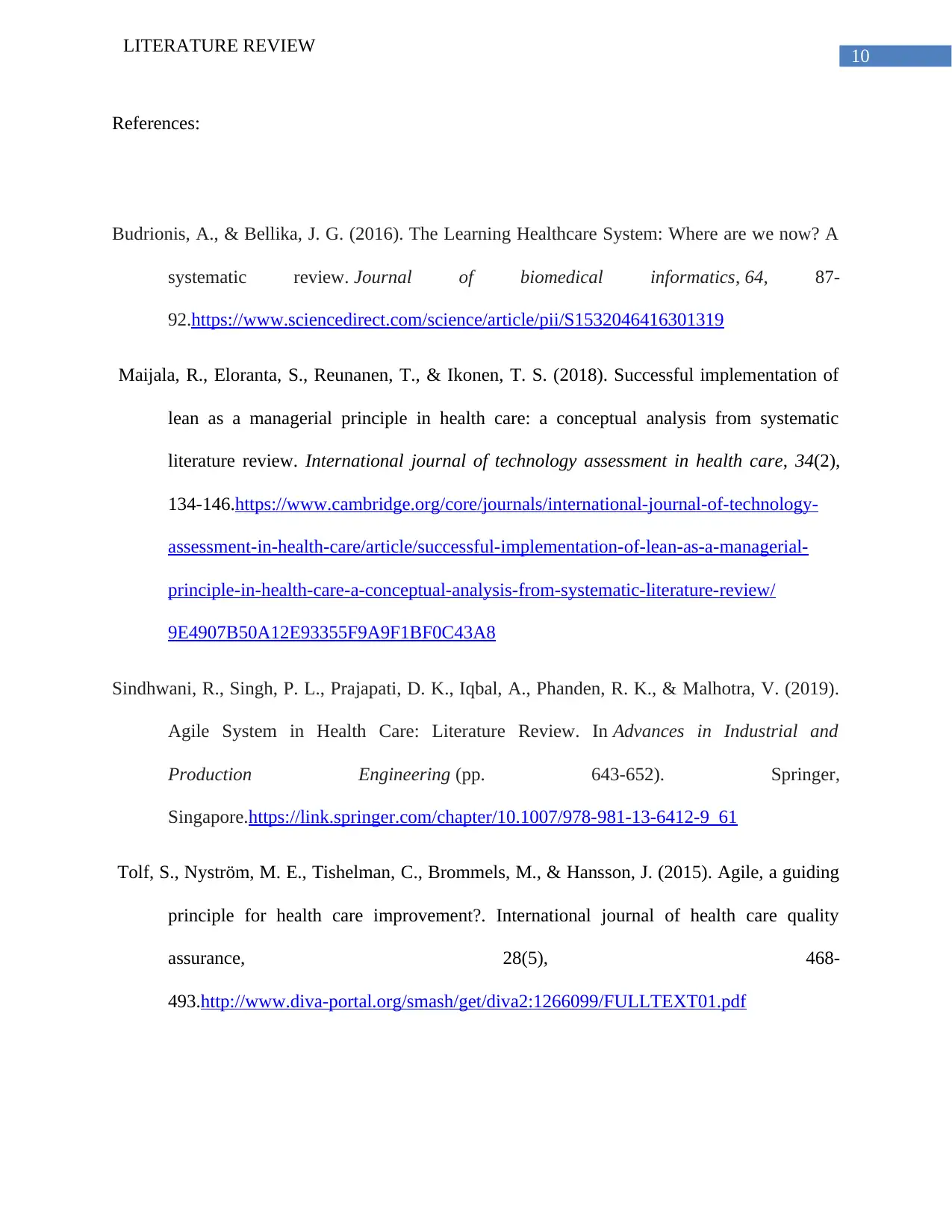
10
LITERATURE REVIEW
References:
Budrionis, A., & Bellika, J. G. (2016). The Learning Healthcare System: Where are we now? A
systematic review. Journal of biomedical informatics, 64, 87-
92.https://www.sciencedirect.com/science/article/pii/S1532046416301319
Maijala, R., Eloranta, S., Reunanen, T., & Ikonen, T. S. (2018). Successful implementation of
lean as a managerial principle in health care: a conceptual analysis from systematic
literature review. International journal of technology assessment in health care, 34(2),
134-146.https://www.cambridge.org/core/journals/international-journal-of-technology-
assessment-in-health-care/article/successful-implementation-of-lean-as-a-managerial-
principle-in-health-care-a-conceptual-analysis-from-systematic-literature-review/
9E4907B50A12E93355F9A9F1BF0C43A8
Sindhwani, R., Singh, P. L., Prajapati, D. K., Iqbal, A., Phanden, R. K., & Malhotra, V. (2019).
Agile System in Health Care: Literature Review. In Advances in Industrial and
Production Engineering (pp. 643-652). Springer,
Singapore.https://link.springer.com/chapter/10.1007/978-981-13-6412-9_61
Tolf, S., Nyström, M. E., Tishelman, C., Brommels, M., & Hansson, J. (2015). Agile, a guiding
principle for health care improvement?. International journal of health care quality
assurance, 28(5), 468-
493.http://www.diva-portal.org/smash/get/diva2:1266099/FULLTEXT01.pdf
LITERATURE REVIEW
References:
Budrionis, A., & Bellika, J. G. (2016). The Learning Healthcare System: Where are we now? A
systematic review. Journal of biomedical informatics, 64, 87-
92.https://www.sciencedirect.com/science/article/pii/S1532046416301319
Maijala, R., Eloranta, S., Reunanen, T., & Ikonen, T. S. (2018). Successful implementation of
lean as a managerial principle in health care: a conceptual analysis from systematic
literature review. International journal of technology assessment in health care, 34(2),
134-146.https://www.cambridge.org/core/journals/international-journal-of-technology-
assessment-in-health-care/article/successful-implementation-of-lean-as-a-managerial-
principle-in-health-care-a-conceptual-analysis-from-systematic-literature-review/
9E4907B50A12E93355F9A9F1BF0C43A8
Sindhwani, R., Singh, P. L., Prajapati, D. K., Iqbal, A., Phanden, R. K., & Malhotra, V. (2019).
Agile System in Health Care: Literature Review. In Advances in Industrial and
Production Engineering (pp. 643-652). Springer,
Singapore.https://link.springer.com/chapter/10.1007/978-981-13-6412-9_61
Tolf, S., Nyström, M. E., Tishelman, C., Brommels, M., & Hansson, J. (2015). Agile, a guiding
principle for health care improvement?. International journal of health care quality
assurance, 28(5), 468-
493.http://www.diva-portal.org/smash/get/diva2:1266099/FULLTEXT01.pdf
1 out of 10
Related Documents
Your All-in-One AI-Powered Toolkit for Academic Success.
+13062052269
info@desklib.com
Available 24*7 on WhatsApp / Email
![[object Object]](/_next/static/media/star-bottom.7253800d.svg)
Unlock your academic potential
Copyright © 2020–2025 A2Z Services. All Rights Reserved. Developed and managed by ZUCOL.





